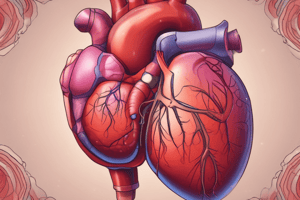Podcast
Questions and Answers
Which type of stool is described as separate hard lumps, like nuts, and is hard to pass?
Which type of stool is described as separate hard lumps, like nuts, and is hard to pass?
- Type 4
- Type 3
- Type 2
- Type 1 (correct)
Which type of stool is described as fluffy pieces with ragged edges and a mushy consistency?
Which type of stool is described as fluffy pieces with ragged edges and a mushy consistency?
- Type 5
- Type 7
- Type 6 (correct)
- Type 4
Which type of stool is described as watery with no solid pieces?
Which type of stool is described as watery with no solid pieces?
- Type 3
- Type 5
- Type 2
- Type 7 (correct)
Which of the following is considered an unstable child with tachycardia?
Which of the following is considered an unstable child with tachycardia?
Which of the following is the initial electrical dose for synchronized cardioversion in a stable child with tachycardia?
Which of the following is the initial electrical dose for synchronized cardioversion in a stable child with tachycardia?
Which of the following is the correct sequence of energy levels for defibrillation in a child with cardiac arrest and a shockable rhythm?
Which of the following is the correct sequence of energy levels for defibrillation in a child with cardiac arrest and a shockable rhythm?
Which of the following is the next step if a child with tachycardia has poor tissue perfusion?
Which of the following is the next step if a child with tachycardia has poor tissue perfusion?
Which of the following is the correct action for a stable child with tachycardia?
Which of the following is the correct action for a stable child with tachycardia?
Which of the following is considered an unstable child with tachycardia?
Which of the following is considered an unstable child with tachycardia?
Which of the following is the initial electrical dose for synchronized cardioversion in a child with tachycardia?
Which of the following is the initial electrical dose for synchronized cardioversion in a child with tachycardia?
Which of the following is the correct energy level for the second shock in defibrillation for a child with cardiac arrest?
Which of the following is the correct energy level for the second shock in defibrillation for a child with cardiac arrest?
Which of the following is the maximum energy level for subsequent shocks in defibrillation for a child with cardiac arrest?
Which of the following is the maximum energy level for subsequent shocks in defibrillation for a child with cardiac arrest?
What should be done if a stable child with tachycardia has poor tissue perfusion?
What should be done if a stable child with tachycardia has poor tissue perfusion?
Flashcards
Type 1 Stool
Type 1 Stool
Separate, hard lumps, like nuts, that are hard to pass.
Type 6 Stool
Type 6 Stool
Fluffy pieces with ragged edges and a mushy consistency.
Type 7 Stool
Type 7 Stool
Watery with no solid pieces.
Tachycardia and Hypotension
Tachycardia and Hypotension
Signup and view all the flashcards
Initial Cardioversion Dose (Stable Child)
Initial Cardioversion Dose (Stable Child)
Signup and view all the flashcards
Defibrillation Energy Sequence (Child)
Defibrillation Energy Sequence (Child)
Signup and view all the flashcards
Tachycardia with Poor Perfusion
Tachycardia with Poor Perfusion
Signup and view all the flashcards
Action for Stable Child with Tachycardia
Action for Stable Child with Tachycardia
Signup and view all the flashcards
Tachycardia and Altered Mental Status
Tachycardia and Altered Mental Status
Signup and view all the flashcards
Initial Cardioversion Dose (Child)
Initial Cardioversion Dose (Child)
Signup and view all the flashcards
Second Defibrillation Shock (Child)
Second Defibrillation Shock (Child)
Signup and view all the flashcards
Maximum Defibrillation Energy (Child)
Maximum Defibrillation Energy (Child)
Signup and view all the flashcards
Poor Tissue Perfusion
Poor Tissue Perfusion
Signup and view all the flashcards
Study Notes
Stool Types
- Separate hard lumps, like nuts, and hard to pass, are described as Type 1 stools.
- Fluffy pieces with ragged edges and a mushy consistency, are described as Type 6 stools.
- Watery with no solid pieces, are described as Type 7 stools.
Tachycardia in Children
- A child with tachycardia and poor tissue perfusion is considered unstable.
- The initial electrical dose for synchronized cardioversion in a stable child with tachycardia is 0.5-1 J/kg.
- The correct sequence of energy levels for defibrillation in a child with cardiac arrest and a shockable rhythm is 2 J/kg, then 4 J/kg, and increasing in increments of 2 J/kg.
- If a child with tachycardia has poor tissue perfusion, the next step is to administer synchronous cardioversion.
- The correct action for a stable child with tachycardia is to monitor and observe.
- A child with tachycardia who has poor tissue perfusion or signs of shock is considered unstable.
- The initial electrical dose for synchronized cardioversion in a child with tachycardia is 0.5-1 J/kg.
- The correct energy level for the second shock in defibrillation for a child with cardiac arrest is 4 J/kg.
- The maximum energy level for subsequent shocks in defibrillation for a child with cardiac arrest is 10 J/kg or the maximum adult dose.
- If a stable child with tachycardia has poor tissue perfusion, the next step is to administer synchronous cardioversion.
Studying That Suits You
Use AI to generate personalized quizzes and flashcards to suit your learning preferences.




